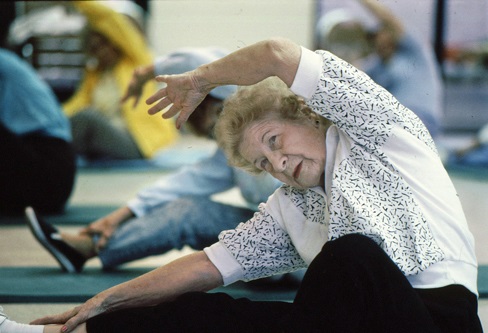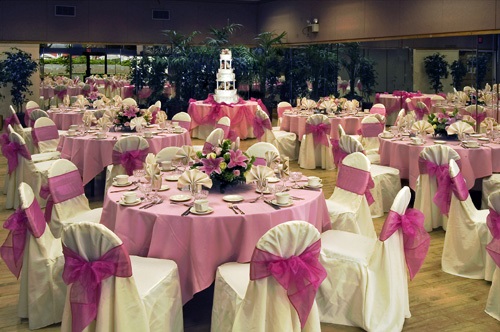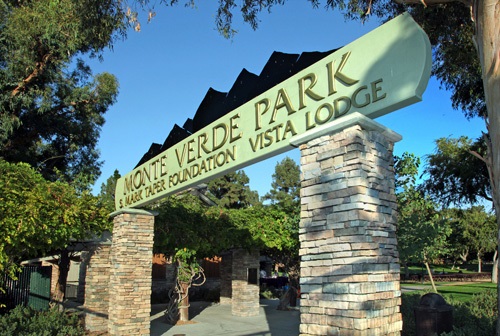When Lakewood ended its first decade of cityhood in 1964, residents and city officials celebrated with a birthday party at city hall. But 1964 also was also a year of mourning, for the city had lost its first mayor, Angelo “Jack” Iacoboni, who died of a heart attack while playing tennis at age 46. The county library in the civic center was rededicated in his honor.
Also in the early 1960s, the city began annexing unincorporated neighborhoods east of the San Gabriel River, bringing the city to its current size of 9.5 square miles.
Recreation for the newly annexed neighborhoods became another city priority. Development of Palms Park – the city’s largest supervised park – began in 1969 with further expansion in 1971. In 1979, using federal Community Development Block Grant funds and a grant from the Weingart Foundation, the city opened a new community center and library at Palms Park.
(Despite efforts by neighborhood residents and the city council, the county library closed the Weingart branch in 1993 during a wave of library budget cuts.)
The city acquired the use of the power line right-of-way on the east bank of the San Gabriel River in 1968 to create River Park, which was dedicated in 1975. The 35-acre park was rededicated as Rynerson Park in 1990 in honor of Jacqueline Rynerson, a member of the city’s first Parks and Recreation Commission and a former city council member.
The city’s park dedication ordinance, adopted in 1968, set aside developer fees to pay for additional park improvements. Many new facilities were added to Lakewood’s parks as a result, including ball diamonds, game courts, sports lighting, playgrounds, and picnic shelters.
 As Lakewood's population aged, recreation programs expanded to include senior activities.
As Lakewood's population aged, recreation programs expanded to include senior activities.
In 1973, the Parks and Recreation Department became the Lakewood Department of Recreation and Community Services, reflecting its expanded functions. The city also began more teen-oriented programs, including job fairs, opportunities for teens to work as Youth Sports Program officials, résumé classes, community activities in conjunction with Lakewood high schools, and computer classes.
To kick off the Bicentennial Year of 1976, two Lakewood High Schools – from Lakewood, California and Lakewood, New Jersey – combined forces to produce the second largest marching band ever to be featured in the history of the Tournament of Roses Parade. Two days earlier, the combined bands had paraded at Disneyland as the largest marching unit in the amusement park's history.
The William J. Burns Community Center on Clark Avenue, built with the help of the Weingart Foundation, was rededicated later that year to honor another member of the original city council. The William J. Burns Community Center has been home to many community services over the years, including the Mothers at Work children’s daycare center, which continues to provide childcare for children two to five years of age.
In 1976, the Lakewood DASH program (Dependable Accessible Senior Handicapped transit) began offering free transportation for elderly and disabled residents. The DASH para-transit service continues to make about 20,000 round trips a year.
In 1981, the Weingart Senior Center opened to serve Lakewood’s older residents. The center today offers a busy calendar of social and cultural events, wellness clinics, human service programs, recreational activities, a fitness center, and a lunchtime senior nutrition program. To better meet the needs of seniors, the Weingart center was expanded in 1988 and renovated in 2001.
Both the Burns and Weingart centers have earned awards for their excellence of design and operation.
 The Centre at Sycamore Plaza is Lakewood's prestige destination for every sort of celebration.
The Centre at Sycamore Plaza is Lakewood's prestige destination for every sort of celebration.
In 1980, the Weingart-Lakewood Family YMCA, funded with a gift from the Weingart Foundation, was dedicated. The foundation provided additional funding in 1983 for the construction of The Centre in the Lakewood Civic Center.
Opened in 1985, The Centre features a 7,000 square-foot assembly room for receptions, cultural events and banquets; meeting rooms totaling more than 5,000 square feet; a 2,500 square-foot arts and crafts studio; the 2,500 square-foot city council chambers; and the 2,000-square-foot CityTV video production facilities.
The city also acquired the land along the eastern bank of the San Gabriel River near Carson Street that had formerly been the Spiller Stables. In 1980, this became the Lakewood Equestrian Center, a boarding facility for horse owners and a training center for riders and their mounts. When Rynerson Park expanded, the equestrian center became part of the park.
Rynerson Park’s $1.4 million expansion project in 1990 included jogging paths, picnic shelters, and an outdoor fitness center, earning the city an environmental award from the California Parks and Recreation Society. Also in 1990, the Mayfair Park activity building was demolished and the John Sanford Todd Community Center and Swim Pavilion, honoring the city’s first city attorney, were built.
Among Lakewood’s most innovative park renovations was Monte Verde Park, which reopened in 2001 with the new S. Mark Taper Foundation Vista Lodge.
 The Vista Lodge at Monte Verde Park hosts day camps and city events.
The Vista Lodge at Monte Verde Park hosts day camps and city events.
From the lodge, park visitors can hike an interpretive trail that meanders among mature trees and ecological niches that tell the story of Southern California’s regional landscapes.
The San Gabriel River Parkway Nature Trail began construction 2002 using mostly grant funding. Planted with indigenous trees, low maintenance meadow grasses, and California wild flowers, the trail recreates the landscape that once flourished along the river channel. Expansion in the following years has extended the nature trail along the entire length of the river in Lakewood.
Lakewood's housing stock also continued to develop through the 1960s and into the 1990s, gaining its first tract of two-story homes in Pennswood Square in 1965. In 1968, the Cherry Cove housing tract in western Lakewood opened. Recognizing the need for more multi-family housing, the city created a multi-family residential zoning ordinance in 1972 that spurred the building of condominium and apartment units.
To provide housing for Lakewood’s seniors, the Candlewood Park senior housing project opened in 1988. Other affordable senior housing projects followed.
 Lakewood continues to celebrate the "great ideas" that sustain community life, as this 55th anniversary banner proclaimed in 2009.
Lakewood continues to celebrate the "great ideas" that sustain community life, as this 55th anniversary banner proclaimed in 2009.
In 1992, Lakewood’s last large tract of undeveloped land became the Westgate development of two-story homes.
In 2004, new city entrance signs – both freestanding signs in street medians and pole-mounted signs – celebrated Lakewood’s achievements in community building. The familiar city symbol remained prominent on the new signs, but it's now accompanied by text that describes Lakewood as a Tree City USA and a Sportstown USA.
The new signs also carry another reminder of Lakewood's history: “Times change. Values don't.” This motto, first used in 2004, brackets the community symbol – a literal embrace of a community vision that has endured the test of time. The shape of the entrance signs is symbolic, too. The peaked cap of the new signs recalls the roofline of a typical Lakewood home – shelter for Lakewood families as well as Lakewood traditions.
In 2009, colorful banners went up on city streets with the motto of Lakewood’s 55th anniversary: “Great ideas last for generations” to celebrate 55 years of innovation in local government. In 2014, Lakewood celebrated 60 years of incorporation with the motto "60 Years of Success" and a display of nostalgic photographs at The Centre.